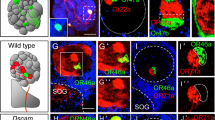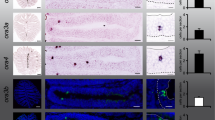Abstract
Candidate Drosophila olfactory receptors (ORs) provide molecular tools to investigate how the organization of the Drosophila olfactory system determines the coding of olfactory stimuli. Neurons in the third antennal segment and maxillary palp appear to express different ORs. Individual olfactory neurons send axonal projections to glomeruli in the antennal lobe. Using transgenic flies, we provide evidence that the neurons expressing a given OR gene, which have cell bodies distributed among neurons expressing other ORs, converge in their projections to topographically fixed glomeruli in the antennal lobe. This convergence allows for the formation of an odotopic map in the antennal lobe whose organization could provide a basis for olfactory discrimination in Drosophila.
This is a preview of subscription content, access via your institution
Access options
Subscribe to this journal
Receive 12 print issues and online access
$209.00 per year
only $17.42 per issue
Buy this article
- Purchase on Springer Link
- Instant access to full article PDF
Prices may be subject to local taxes which are calculated during checkout





Similar content being viewed by others
References
Carlson, J. R. Olfaction in Drosophila: from odor to behavior. Trends Genet. 12, 175–180 ( 1996).
Smith, D. P. Olfactory mechanisms in Drosophila melanogaster. Curr. Opin. Neurobiol. 6, 500–505 ( 1996).
Charro, M. J. & Alcorta, E. Quantifying relative importance of maxillary palp information on the olfactory behavior of Drosophila melanogaster . J. Comp. Physiol. A 175, 761– 766 (1994).
Stocker, R. F. The organization of the chemosensory system in Drosophila melanogaster : a review. Cell Tissue Res. 275, 3– 26 (1994).
Stocker, R. F., Singh, R. N., Schorderet, M. & Siddiqi, O. Projection patterns of different types of antennal sensilla in the antennal glomeruli of Drosophila melanogaster. Cell Tissue Res. 232, 237–248 (1983).
Stocker, R. F., Lienhard, M. C., Borst, A. & Fischbach, K. F. Neuronal architecture of the antennal lobe in Drosophila melanogaster. Cell Tissue Res. 262, 9–34 (1990).
Gao, Q. & Chess, A. Identification of candidate Drosophila olfactory receptors from genomic DNA sequence. Genomics 60, 31–39 (1999).
Clyne, P. et al. A novel family of divergent seven-transmembrane proteins: candidate odorant receptors in Drosophila. Neuron 22, 327–338 (1999).
Vosshall, L., Amrein, H., Morozov, P., Rzhetsky, A. & Axel, R. A spatial map of olfactory receptor expression in the Drosophila antenna. Cell 96, 725– 736 (1999).
Rubin, G. M. Comparative genomics of the eukaryotes. Science 287 , 2204–2215 (2000).
Sengupta, P., Chou, J. H. & Bargmann, C. I. odr-10 encodes a seven transmembrane domain olfactory receptor required for responses to the odorant diacetyl. Cell 84, 899–909 (1996).
Troemel, E. R., Chou, J. H., Dwyer, N. D., Colbert, H. A. & Bargmann, C. I. Divergent seven transmembrane receptors are candidate chemosensory receptors in C. elegans. Cell 83, 207–218 (1995).
Buck, L. & Axel, R. A novel multigene family may encode odorant receptors: a molecular basis for odor recognition. Cell 65, 175–187 ( 1991).
Ngai, J., Dowling, M. M., Buck, L., Axel, R. & Chess, A. The family of genes encoding odorant receptors in the channel catfish. Cell 72, 657–666 ( 1993).
Ebrahimi, F. A. & Chess, A. The specification of olfactory neurons. Curr. Opin. Neurobiol. 8, 453–457 (1998).
Ressler, K. J., Sullivan, S. L. & Buck, L. B. A zonal organization of odorant receptor gene expression in the olfactory epithelium. Cell 73, 597 –609 (1993).
Vassar, R., Ngai, J. & Axel, R. Spatial segregation of odorant receptor expression in the mammalian olfactory epithelium. Cell 74, 309– 318 (1993).
Nef, P. et al. Spatial pattern of receptor expression in the olfactory epithelium . Proc. Natl. Acad. Sci. USA 89, 8948– 8952 (1992).
Strotmann, J., Wanner, I., Krieger, J., Raming, K. & Breer, H. Expression of odorant receptors in spatially restricted subsets of chemosensory neurones. Neuroreport 3, 1053–1056 (1992).
Dulac, C. & Axel, R. A novel family of genes encoding putative pheromone receptors in mammals. Cell 83, 195–206 (1995).
Matsunami, H. & Buck, L. B. A multigene family encoding a diverse array of putative pheromone receptors in mammals. Cell 90, 775–784 (1997).
Herrada, G. & Dulac, C. A novel family of putative pheromone receptors in mammals with a topographically organized and sexually dimorphic distribution. Cell 90, 763– 773 (1997).
Ryba, N. J. & Tirindelli, R. A new multigene family of putative pheromone receptors. Neuron 19, 371– 379 (1997).
Rodrigues, V. Spatial coding of olfactory information in the antennal lobe of Drosophila melanogaster. Brain Res. 453, 299– 307 (1988).
Joerges, J., Kuttner, A., Galizia, C. & Menzel, R. Presentations of odours and odour mixtures visualized in the honeybee brain. Nature 387, 285–288 ( 1997).
Faber, T., Joerges, J. & Menzel, R. Associative learning modifies neural representations of odors in the insect brain. Nat. Neurosci. 2, 74–78 (1999).
Galizia, C. G., Sachse, S., Rappert, A. & Menzel, R. The glomerular code for odor representation is species specific in the honeybee Apis mellifera . Nat. Neurosci. 2, 473– 478 (1999).
Adams, M. et al. The genome sequence of Drosophila melanogaster. Science 287, 2185–2195 ( 2000).
Callahan, C. A. & Thomas, J. B. Tau-beta-galactosidase, an axon-targeted fusion protein. Proc. Natl. Acad. Sci. USA 91, 5972–5976 (1994).
Mombaerts, P. et al. Visualizing an olfactory sensory map. Cell 87, 675–686 (1996).
Ito, K. et al. The organization of extrinsic neurons and their implications in the functional roles of the mushroom bodies in Drosophila melanogaster Meigen. Learn. Mem. 5, 52– 77 (1998).
Laissue, P. P. et al. Three-dimensional reconstruction of the antennal lobe in Drosophila melanogaster. J. Comp. Neurol. 405, 543–552 (1999).
Chess, A., Simon, I., Cedar, H. & Axel, R. Allelic inactivation regulates olfactory receptor gene expression. Cell 78, 823–834 (1994).
Rodriguez, I., Feinstein, P. & Mombaerts, P. Variable patterns of axonal projections of sensory neurons in the mouse vomeronasal system. Cell 97, 199–208 (1999).
Belluscio, L., Koentges, G., Axel, R. & Dulac, C. A map of pheromone receptor activation in the mammalian brain. Cell 97 , 209–220 (1999).
Vassar, R. et al. Topographic organization of sensory projections to the olfactory bulb. Cell 79, 981–991 (1994).
Ressler, K. J., Sullivan, S. L. & Buck, L. B. Information coding in the olfactory system: evidence for a stereotyped and highly organized epitope map in the olfactory bulb. Cell 79, 1245–1255 ( 1994).
Hafen, E. & Levine, M. in Drosophila: A Practical Approach (ed. Roberts, D.) 139–157 (IRL, Oxford, 1986).
Acknowledgements
We thank P. Qi and I. Van Wesep for technical assistance, N. Watson for help with confocal analyses, F. Lewitter for help with database analyses, J. Cook-Chrysos for artwork and A. Harry for preparation of the manuscript. We thank F. Ebrahimi, P. Garrity, I. Rebay, P. Sklar and members of the Chess laboratory for advice and critical comments. A.C. is a Rita Allen Foundation Scholar. This work was done in the W.M. Keck Foundation Biological Imaging Facility at the Whitehead Institute.
Author information
Authors and Affiliations
Corresponding author
Rights and permissions
About this article
Cite this article
Gao, Q., Yuan, B. & Chess, A. Convergent projections of Drosophila olfactory neurons to specific glomeruli in the antennal lobe. Nat Neurosci 3, 780–785 (2000). https://doi.org/10.1038/77680
Received:
Accepted:
Issue Date:
DOI: https://doi.org/10.1038/77680
This article is cited by
-
Polymer Physics-Based Classification of Neurons
Neuroinformatics (2023)
-
Interspecific variation of antennal lobe composition among four hornet species
Scientific Reports (2021)
-
A neural m6A/Ythdf pathway is required for learning and memory in Drosophila
Nature Communications (2021)
-
GPCR voltage dependence controls neuronal plasticity and behavior
Nature Communications (2021)
-
Untangling the wires: development of sparse, distributed connectivity in the mushroom body calyx
Cell and Tissue Research (2021)



